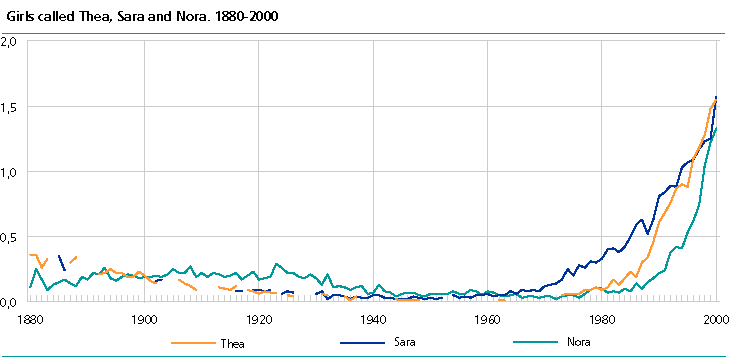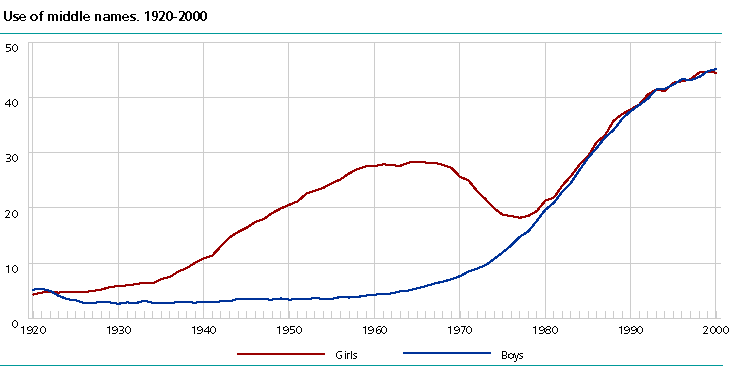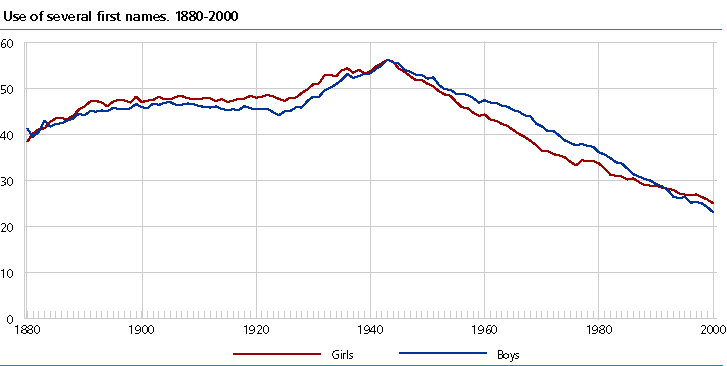Content
Published:
This is an archived release.
Emilie and Markus most popular names
The name Emilie skyrocketed in popularity in the 1990s. The peak has been reached but Emilie is still hanging on to first place, closely followed by Ida. Markus (or Marcus) attained comet status in 1997, and has since been one of the two most popular names for boys. In 2000 it ranked No. 1.
Stability
The use of names is marked by stability. The most commonly used names remain popular for a very long time. Kristian (or Christian), the second most popular name for boys, has been in the Top 10 since 1974. There is another type of stability, too. Ascending names have a tendency to climb the ladder of popularity for several years. The girls names Thea (in 3rd place), Sara (6th place) and Nora (9th place) have been making steady advances for 20 years.
The rise and fall of names
Mathilde, Mia, Simen and Sebastian made the most headway last year while Maren and Thomas declined the most in the rankings. Thomas is now off the Top 10 list after 29 years. Camilla fell off the list in 1998 after 22 years and is now down to 24th place. When we look at the changes that have taken place since 1995, the girls name Silje, which has now disappeared from the list after being on it for 20 years, is the only name to fall faster in popularity.
Good diversity
Girls names are more subject to the whims of fashion than boys names. Boys names never completely drop off the radar screen like girls names, and the selection of useable girls names is larger. Although 532 baby girls were named Emilie last year, this accounts for only 1.8 per cent of all girls named that year. Markus (or Marcus) claimed 2.0 per cent.
By comparison, in 2000 Julia was the most popular name in Sweden, with 2.8 per cent and Filip with 2.5 per cent. The latest available statistics from Denmark are for the first half of 2000. Sofie tops the list there with 3.0 per cent and Mathias with 3.2 per cent. The trend in Sweden and Denmark is also towards greater diversity of names.
Geographic variations
In smaller areas circumstances can play a role. Simen was the most popular name in both Oppland and Hedmark counties. Ole has fallen back to 21st place nationally, but is first in Aust-Agder. In Oslo, with its largest community of immigrants, various spellings of Mohammed are in 3rd place, up from 8th place the year before.
Amalie has declined slightly on a national basis, to No. 20, but she is No. 2 in Aust- and Vest-Agder, Stavanger, Hordaland and Bergen, and No. 3 in Sogn og Fjordane. In 1999 Amalie was No. 2 in Rogaland and Hordaland. There are clear geographical differences here.
In Bærum, Herman shares 1st place. Helene is still popular, although she only managed 5th place this year. Is it a coincidence that Henrik and Hedda are also names that have proved popular in Bærum?
More names
25.1 per cent of the girls and 22.8 per cent of the boys have more than one first name. In addition, 1.6 per cent of the boys and 1.8 per cent of the girls have hyphenated names. In 1943, 55 per cent had more than one first name. The use of more than one name may have something to do with the length of the first forename and the use of middle names. When children are given both their mothers and fathers surname, two first names can be a bit much. 44.5 per cent of the girls and 45.1 of the boys are now given middle names.
The most popular double names are Ida Marie, Silje Marie and Thea Marie. The most commonly used second name is in a class by itself: Marie, used 733 times, against Sofie 319 and Elise 264. Among boys, Ole Martin, Kim André and Ole Kristian are the most popular double names. The leader here is also unmatched, all of 568 have André as a second first name, against 247 who have Andreas and 194 who have Alexander.
Annual or freshest possible statistics?
The statistics are prepared on the basis of the 30 649 boys and 28 988 girls who were given names in 2000. In Norway parents have six months to report the name they have given their newborn. This means that 10 502 of these children were born (late) in 1999. The reason it is done this way is to provide the freshest possible picture of the name situation, while also providing statistics for a whole year. The rankings may change somewhat when statistics are subsequently compiled for all children born in the same year. For example, Markus was No. 2 in last years statistics, but will take 1st place when the 1999 summary is redone. Similarly, it is quite possible that Ida will surpass Emilie when the final figures for 2000 are ready. The Top 10 list for every year since 1880 is on the Net.
Contact
-
Margrete Sveinsdatter Rydjord
E-mail: margrete.rydjord@ssb.no
tel.: (+47) 95 05 59 57



